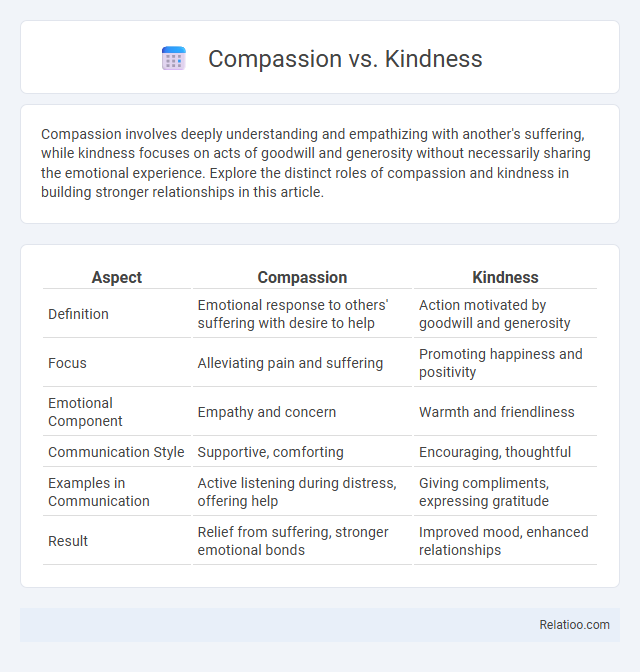Compassion involves deeply understanding and empathizing with another's suffering, while kindness focuses on acts of goodwill and generosity without necessarily sharing the emotional experience. Explore the distinct roles of compassion and kindness in building stronger relationships in this article.
Table of Comparison
| Aspect | Compassion | Kindness |
|---|---|---|
| Definition | Emotional response to others' suffering with desire to help | Action motivated by goodwill and generosity |
| Focus | Alleviating pain and suffering | Promoting happiness and positivity |
| Emotional Component | Empathy and concern | Warmth and friendliness |
| Communication Style | Supportive, comforting | Encouraging, thoughtful |
| Examples in Communication | Active listening during distress, offering help | Giving compliments, expressing gratitude |
| Result | Relief from suffering, stronger emotional bonds | Improved mood, enhanced relationships |
Understanding Compassion: Definition and Depth
Compassion involves recognizing the suffering of others and deeply empathizing with their pain, prompting a desire to alleviate it. Unlike kindness, which often manifests as simple acts of goodwill or generosity, compassion requires an emotional connection and a willingness to engage with others' distress. Understanding compassion means acknowledging its profound depth as an active, empathetic response rather than a passive feeling or occasional kindness.
What is Kindness? An Overview
Kindness is the quality of being friendly, generous, and considerate, often expressed through actions that benefit others without expecting anything in return. It involves genuine concern for another's well-being and can manifest as simple gestures like helping, listening, or offering support. Your acts of kindness create positive social connections and foster a more empathetic community.
Key Differences Between Compassion and Kindness
Compassion involves recognizing someone's suffering and feeling motivated to alleviate it, while kindness refers to performing actions that are considerate and beneficial to others without necessarily feeling empathy. Compassion is an emotional response tied to empathy, leading to supportive behavior, whereas kindness is a broader concept encompassing acts that promote goodwill regardless of emotional connection. Understanding this distinction highlights that compassion drives a deeper, empathetic engagement, whereas kindness emphasizes positive actions that may or may not stem from such empathy.
The Psychology Behind Compassion
The psychology behind compassion reveals it as an emotional response involving empathy for another's suffering combined with a genuine desire to help, distinct from kindness, which is a broader behavior motivated by goodwill without necessarily empathizing with pain. Compassion activates specific neural pathways associated with caregiving and distress regulation, promoting prosocial behavior and emotional resilience. Studies show that cultivating compassion can decrease stress, enhance social bonding, and improve overall mental health more profoundly than kindness alone.
How Kindness Impacts Human Connection
Kindness strengthens human connection by fostering trust, empathy, and emotional support, creating a positive social environment. Acts of kindness promote psychological well-being, enhancing relationships and encouraging reciprocal support. Consistent kindness builds social bonds, reducing isolation and increasing overall community resilience.
Compassion in Action: Real-World Examples
Compassion in action involves recognizing others' suffering and actively working to alleviate it through tangible efforts such as volunteering at shelters, providing medical aid in crisis zones, or supporting mental health initiatives. Unlike kindness, which often consists of simple gestures, compassion requires deeper empathy combined with proactive measures to create meaningful change. Real-world examples include organizations like Doctors Without Borders, which exemplify compassion by delivering critical healthcare directly to those in urgent need.
Everyday Ways to Practice Kindness
Practicing kindness in everyday life involves simple actions such as offering a genuine compliment, holding the door for someone, or actively listening when someone shares their feelings. Your small gestures of kindness can create ripple effects that foster positive connections and emotional well-being in your community. Prioritizing kindness over mere politeness transforms interactions into meaningful experiences that uplift both you and those around you.
The Role of Empathy in Compassion and Kindness
Empathy serves as the foundation for both compassion and kindness by enabling you to deeply understand and share the feelings of others. Compassion involves a proactive response to alleviate suffering, driven by empathetic insight, while kindness reflects everyday acts of goodwill motivated by genuine care. Your ability to empathize enhances these qualities, fostering meaningful connections and promoting emotional support in personal and social interactions.
Compassion and Kindness in Relationships
Compassion in relationships involves recognizing and empathizing with a partner's suffering, fostering deep emotional connections and supportive behaviors that promote healing and understanding. Kindness manifests as deliberate acts of generosity and consideration, such as offering help or expressing gratitude, which build trust and reinforce positive interactions. Together, compassion and kindness create a foundation for resilient relationships by encouraging emotional safety and mutual care.
Building a Life Rooted in Compassion and Kindness
Building a life rooted in compassion and kindness requires understanding that compassion involves deeply empathizing with others' suffering, while kindness focuses on actions that promote goodwill and care. Cultivating these qualities enhances your relationships and creates a positive ripple effect in your community, fostering trust and emotional support. Embracing both compassion and kindness daily empowers you to contribute meaningfully to a more empathetic and connected world.

Infographic: Compassion vs Kindness
 relatioo.com
relatioo.com